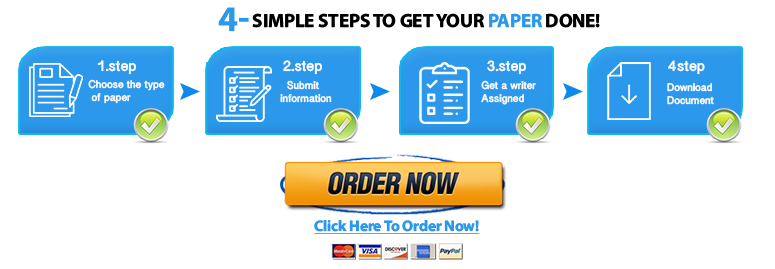Assignment 3: Kotter Change Management ModelDue Week 6Using WalMart, apply Kotter’s eight (8) steps of change management to an HR situation you have selected for change. You will address all eight (8) of the Kotter steps, developing an action plan for each step. Use a tablet, smartphone, laptop, desktop, or traditional video recorder to record a maximum of a five to seven (5-7) minute dynamic video on the topics detailed below. Alternatively, you may submit a four to six (4-6) page paper instead of the video submission.Note: If you are using a tablet or smartphone you will need to email the video file to yourself, then save it to a computer in order to upload to Blackboard. You may want to upload your video to a file sharing service, such as Dropbox, if your email will not let you send a large video file. Dropbox is accessible from all smartphones and tablets from the Dropbox app.Once you are ready to upload your video to Blackboard, click here to view the “Student Video Assignment Submission” video tutorial in the “Creating a Presentation for Your Course” playlist.Please use the following naming convention in the popup window for your video once it is finished uploading:Title: Your First Name, Your Last Name – Managing Organizational ChangeTags: HRM560, Organizational ChangeDescription: First Name, Last Name – HRM560 Assignment 3 (Date Uploaded ex. 11-14-2014)Prepare and present a video that is a maximum of five to seven (5-7) minutes OR write a four to six (4-6) page paper in which you:Ascertain how each of the steps applies to your specific organization.Develop a strategy that illustrates how you would address each of the eight (8) stages of change:Establishing a sense of urgencyCreating coalitionDeveloping vision and strategyCommunicating the visionEmpowering broad-based actionGenerating short-term winsConsolidating gains and producing more changeAnchoring new approaches into the cultureUse at least four (4) quality academic resources in this assignment. Note: Wikipedia and other similar Websites do not qualify as academic resources.Note: If you choose to submit a video presentation, please also submit a one (1) page summary of your presentation.If you choose the written paper, your assignment must follow these formatting requirements:Be typed, double spaced, using Times New Roman font (size 12), with one-inch margins on all sides; citations and references must follow APA or school-specific format. Check with your professor for any additional instructions.Include a cover page containing the title of the assignment, the student’s name, the professor’s name, the course title, and the date. The cover page and the reference page are not included in the required assignment page length.The specific course learning outcomes associated with this assignment are:Compare theories of change management and select an appropriate theory for an organization change.Analyze diagnostic models relevant to various aspects of the change management process.Use technology and information resources to research issues in managing organizational change.Write clearly and concisely about managing organizational change using proper writing mechanics.Identify organizational changes that link to vision.Assignment 3: Kotter Change Management ModelCriteriaUnacceptableBelow 70% FFair70-79% CProficient80-89% BExemplary90-100% A1. Ascertain how each of the steps applies to your specific organization.Weight: 5%Did not submit or incompletely ascertained how each of the steps applies to your specific organization.Partially ascertained how each of the steps applies to your specific organization.Satisfactorily ascertained how each of the steps applies to your specific organization.Thoroughly ascertained how each of the steps applies to your specific organization.2a. Develop a strategy that illustrates how you would address each of the eight (8) stages of change: establishing a sense of urgency.Weight: 10%Did not submit or incompletely developed a strategy that illustrates how you would address each of the eight (8) stages of change: establishing a sense of urgency.Partially developed a strategy that illustrates how you would address each of the eight (8) stages of change: establishing a sense of urgency.Satisfactorily developed a strategy that illustrates how you would address each of the eight (8) stages of change: establishing a sense of urgency.Thoroughly developed a strategy that illustrates how you would address each of the eight (8) stages of change: establishing a sense of urgency.2b. Develop a strategy that illustrates how you would address each of the eight (8) stages of change: creating coalition.Weight: 10%Did not submit or incompletely developed a strategy that illustrates how you would address each of the eight (8) stages of change: creating coalition.Partially developed a strategy that illustrates how you would address each of the eight (8) stages of change: creating coalition.Satisfactorily developed a strategy that illustrates how you would address each of the eight (8) stages of change: creating coalition.Thoroughly developed a strategy that illustrates how you would address each of the eight (8) stages of change: creating coalition.2c. Develop a strategy that illustrates how you would address each of the eight (8) stages of change: developing vision and strategy.Weight: 10%Did not submit or incompletely developed a strategy that illustrates how you would address each of the eight (8) stages of change: developing vision and strategy.Partially developed a strategy that illustrates how you would address each of the eight (8) stages of change: developing vision and strategy.Satisfactorily developed a strategy that illustrates how you would address each of the eight (8) stages of change: developing vision and strategy.Thoroughly developed a strategy that illustrates how you would address each of the eight (8) stages of change: developing vision and strategy.2d. Develop a strategy that illustrates how you would address each of the eight (8) stages of change: communicating the vision.Weight: 10%Did not submit or incompletely developed a strategy that illustrates how you would address each of the eight (8) stages of change: communicating the vision.Partially developed a strategy that illustrates how you would address each of the eight (8) stages of change: communicating the vision.Satisfactorily developed a strategy that illustrates how you would address each of the eight (8) stages of change: communicating the vision.Thoroughly developed a strategy that illustrates how you would address each of the eight (8) stages of change: communicating the vision.2e. Develop a strategy that illustrates how you would address each of the eight (8) stages of change: empowering broad-based action.Weight: 10%Did not submit or incompletely developed a strategy that illustrates how you would address each of the eight (8) stages of change: empowering broad-based action.Partially developed a strategy that illustrates how you would address each of the eight (8) stages of change: empowering broad-based action.Satisfactorily developed a strategy that illustrates how you would address each of the eight (8) stages of change: empowering broad-based action.Thoroughly developed a strategy that illustrates how you would address each of the eight (8) stages of change: empowering broad-based action.2f. Develop a strategy that illustrates how you would address each of the eight (8) stages of change: generating short- term wins.Weight: 10%Did not submit or incompletely developed a strategy that illustrates how you would address each of the eight (8) stages of change: generating short- term wins.Partially developed a strategy that illustrates how you would address each of the eight (8) stages of change: generating short- term wins.Satisfactorily developed a strategy that illustrates how you would address each of the eight (8) stages of change: generating short- term wins.Thoroughly developed a strategy that illustrates how you would address each of the eight (8) stages of change: generating short- term wins.2g. Develop a strategy that illustrates how you would address each of the eight (8) stages of change: consolidating gains and producing more change.Weight: 10%Did not submit or incompletely developed a strategy that illustrates how you would address each of the eight (8) stages of change: consolidating gains and producing more change.Partially developed a strategy that illustrates how you would address each of the eight (8) stages of change: consolidating gains and producing more change.Satisfactorily developed a strategy that illustrates how you would address each of the eight (8) stages of change: consolidating gains and producing more change.Thoroughly developed a strategy that illustrates how you would address each of the eight (8) stages of change: consolidating gains and producing more change.2h. Develop a strategy that illustrates how you would address each of the eight (8) stages of change: anchoring new approaches into the culture.Weight: 10%Did not submit or incompletely developed a strategy that illustrates how you would address each of the eight (8) stages of change: anchoring new approaches into the culture.Partially developed a strategy that illustrates how you would address each of the eight (8) stages of change: anchoring new approaches into the culture.Satisfactorily developed a strategy that illustrates how you would address each of the eight (8) stages of change: anchoring new approaches into the culture.Thoroughly developed a strategy that illustrates how you would address each of the eight (8) stages of change: anchoring new approaches into the culture.3. 4 ReferencesWeight: 5%No references provided.Does not meet the required number of references; some or all references poor quality choices.Meets number of required references; all references high quality choices.Exceeds number of required references; all references high quality choices.4. Clarity / Coherence in Presentation and writing mechanicsWeight: 5%More than 6 errors present. Information is confusing and fails to include reasons and evidence that logically support ideas.5-6 errors present. Information is partially clear with minimal reasons and evidence that logically support ideas.3-4 errors present. Information is mostly clear and generally supported with reasons and evidence that logically support ideas.0-2 errors present. Information is provided in a clear, coherent, and consistent manner with reasons and evidence that logically support ideas.5. Met formatting requirements, including one (1) page summary for presentation option.Weight: 5%Did not submit or incompletely met formatting requirements, including one (1) page summary for presentation option.Partially met formatting requirements, including one (1) page summary for presentation option.Satisfactorily met formatting requirements, including one (1) page summary for presentation option.Thoroughly met formatting requirements, including one (1) page summary for presentation option.
"Looking for a Similar Assignment? Order now and Get 10% Discount! Use Code "Newclient"





